
Полная версия
Plant Solutions
Companion plants: Superb for long-lasting bedding, as well as for gap filling or providing winter interest in containers. Pretty with small bulbs such as Muscari, or with such spring plants as wallflowers or Aubrieta.
Primula vulgaris
Hybrid Primroses Perennial
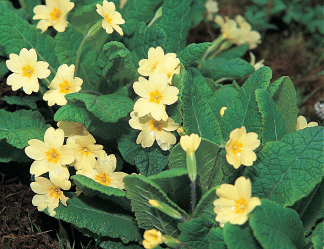
Rosette-forming with broad, deeply veined, oval leaves and from winter through spring, a succession of five-petalled flowers. The wild species has pale yellow or flush mauve blooms but garden hybrids vary in flower size and colour. Red, blue, yellow, orange, pink and white hues are common. Sweetly fragrant. Should be divided and replanted regularly.
Soil preference: Medium to heavy, moisture retentive
Aspect: Shade or part shade
Season of interest: Spring
Height and spread: To 15cm × 20cm (6in × 8in)
Companion plants: Attractive bedded on their own, or with such spring bulbs as Muscari, Tulipa or smaller Narcissus such as N. ‘Hawera’ for companions. Also excellent as container plants.
Primula elatior hybrids
Polyanthus short-lived perennials
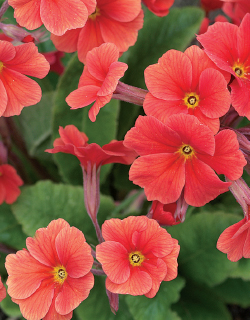
Leaves as primroses but the primula flowers appear in loose umbels of several blooms atop stems which may extend to 30cm. Developed from the wild oxlip, whose flowers are butter yellow, but cultivars come in all shades making them useful for colour scheming. Deadhead and remove yellowing leaves regularly. Divide annually and watch for vine weevil.
Soil preference: Moisture retentive
Aspect: Shade or partial shade, excellent under deciduous trees
Season of interest: Spring
Height and spread: Up to 30cm × 20cm (1ft × 8in)
Companion plants: Excellent for partially shaded bedding schemes but perfectly happy in full sun when they are bedded out in autumn and lifted in late spring after flowering.
Doronicum ‘Leopard’s Bane’
Perennial
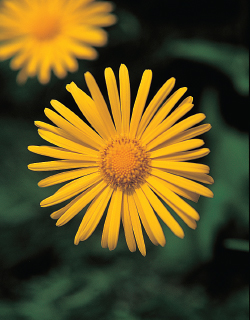
Bright green, heart-shaped, slightly toothed leaves which form a basal clump as well as furnishing the flower stems. These lengthen in mid-spring, and bear big, golden daisy flowers which last into early summer. The foliage tends to burn away in hot weather.
Soil preference: Moist but free-draining
Aspect: Part-shade or shade. Excellent under deciduous trees
Season of interest: Spring
Height and spread: 30cm × 60cm (1ft × 2ft)
Companion plants: Beautiful planted with contrasting tulips such as the scarlet ‘Apeldoorn’ or deep purple ‘Negrita’. Also interesting when teamed with aquilegias, which will extend the flowering season further into summer.
Bedding: summer flowering, full sun
Petunia
Petunias Perennial (frost tender)
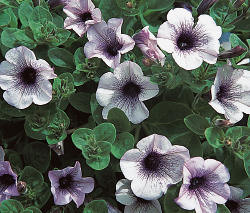
The most widely grown bedding plant, worldwide. A mat-forming herbaceous plant with oval leaves and a constant succession of vivid, saucer-shaped, fragrant flowers. Flowers can be ruined by damp weather, but blooming is copious. Wide colour range available, some with stripes, edging or darker veins. Series include ‘Mirage’, ‘Wave’, ‘Celebrity’ and trailing ‘Surfinia’.
Soil preference: Any, not wet
Aspect: Full sun
Season of interest: Summer
Height and spread: Various, to 30cm × 60cm (1ft × 2ft)
Companion plants: Traditionally bedded on their own or with contrasting colours of bedding salvias or tagetes, petunias are also useful for gap filling in mixed planting schemes and for containers.
Tagetes patula, T. tenuifolia
French/African/Afro-French Marigold, Tagetes Annual

Annuals with divided, sometimes filigree foliage and a succession of flowers in hot hues from yellow, through gold to orange, red or pale cream. African Marigolds such as ‘Antigua Gold’ grow tallest; French Marigolds such as ‘Little Hero’ (orange) or ‘Safari’ series are mid-height; and Tagetes such as ‘Starfire’ form sprays of yellow or orange flowers.
Soil preference: Free-draining, fertile
Aspect: Sun
Season of interest: Summer
Height and spread: Variable up to 60cm × 45cm (up to 2ft × 1ft 6in)
Companion plants: These hot colours are difficult to team in more naturalistic bedding schemes but their power and distinctive aroma make them great value for bulking up summer colour. Tagetes are superb with blue daisies such as Felicia amelloides.
Pelargonium hybrids
Geraniums Tender perennials
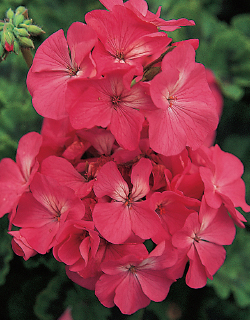
A huge group of highly popular perennials, originating almost exclusively from Africa but hybridized and grown all over the world. Sizes vary from miniature hybrids and dwarf species to the largest kinds such as P. papilionaceum which can exceed 2m (6ft) in height and width. The single or double blooms occur in sprays or small clusters. Colours include most shades excluding blue and yellow. Zonal types have darker or lighter banding on leaves.
Soil preference: Any free-draining
Aspect: Full sun
Season of interest: Summer
Height and spread: Variable
Companion plants: Traditionally bedded on their own with contrasting ‘dot plants’. Red zonals look good with pale blue Plumbago or purple Cordyline; pink or violet can be set off with standard fuchsias or Abutilon.
Verbena hybrid cultivars
Tender perennials
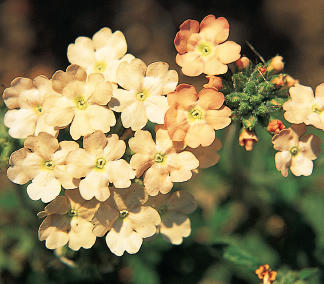
Plants have lobed leaves and flattened flower umbels which attract butterflies. Those with a spreading habit include the vigorous ‘Homestead Purple’ which may overwinter, the old cultivar ‘Sissinghurst’ with abundant pink blooms and the popular ‘Tapien’ and ‘Temari’ series which offer a wide colour range. ‘Quartz’ is an excellent upright bedder from seed.
Soil preference: Well-drained
Aspect: Sun
Season of interest: Summer
Height and spread: Up to 30cm (1ft), spreading
Companion plants: Spreading or trailing types work well as temporary summer groundcover spilling onto the patio or in containers. Try dotting with taller plants such as Lobelia ‘Compliment Series’. Upright bedding verbenas contrast nicely with petunias.
Dahlia hybrid bedding varieties
Perennial
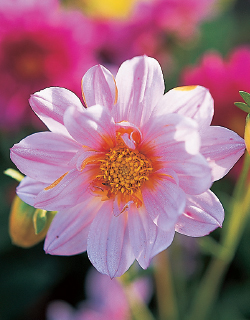
Variable range of tender perennials developed from Central American species. These hybrids vary in height from dwarf, compact and bushy forms with smaller blooms suitable for containers and low bedding to tall upright types, often with spectacular flowers, that add colour and drama to the late summer border. Bedding dahlias are usually raised from seed and discarded at the end of the season. Lift dahlia tubers after first frosts.
Soil preference: Fertile, well-drained but not too dry
Aspect: Sun
Season of interest: Summer, autumn
Height and spread: From 30cm to 1.75m (1ft to 5ft)
Companion plants: Taller, large-flowered dahlias are excellent in a mixed border with late flowering perennials such as asters and crocosmias. Compact, tuberous or seed raised dahlias combine well with red bedding salvias and Solenostemon (Coleus).
Antirrhinum majus
Snapdragons Short-lived perennial
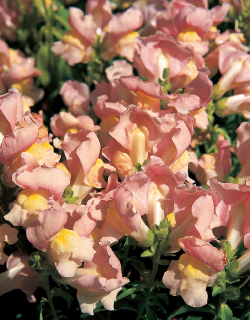
Herbaceous plants with simple leaves and spikes bearing lipped flowers which, when squeezed, open like jaws. Colours range from white and pale yellow through pinks and crimson to scarlet red or orange. Prone to rust disease. More resistant seed strains are available but to reduce rust problems remove surviving plants at the end of the season. Series include the dwarf ‘Chimes’ and taller ‘Liberty’.
Soil preference: Fertile, well-drained
Aspect: Sun or part shade
Season of interest: Summer, autumn
Height and spread: To 45cm–1m (1ft 6in–3ft 3in) for cutting varieties
Companion plants: Excellent as link plants between spring and summer bedding, since they can be planted out in very early spring before the frost risk has passed. Try them after tulips or polyanthus.
Bedding: summer flowering, dappled shade
Salvia splendens
Scarlet Sage, Bedding Salvia Tender perennial
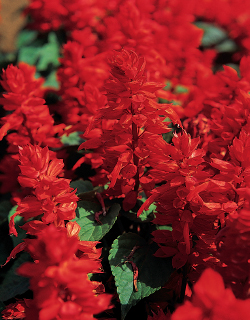
Shrubby perennial with angular stems and toothed, nettlelike leaves. The flowers are sheathed in colourful bracts and, in the wild species, are vivid red. Garden forms, which come in red, pink or purplish hues, include ‘Scarlet King’, ‘Empire Purple and ‘Vista Salmon’. The ‘Sizzler’ series are smaller, more compact plants in a similar colour range.
Soil preference: Rich, not too dry, but well-drained
Aspect: Part-shade or sun
Season of interest: Summer, early autumn
Height and spread: Up to 1.2m (4ft), but usually grown shorter
Companion plants: A good choice for part-shaded bedding schemes or for high rainfall areas. The strong colours work well with sombre heliotropes or with the rich foliage patterns of Plectranthus or with Solenostemon (Coleus).
Impatiens walleriana hybrids
Busy Lizzie, Balsam Tender perennial
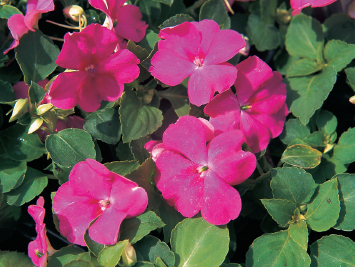
Shrubby perennials with thick but brittle stems and smooth, glossy, slightly toothed leaves. The flowers are flattened, asymmetrical and come in a broad range of hues from red, through mauve, pink or salmon to white. F1 hybrid seed strains offer single colours. Some types are picotee edged, striped or have ‘eyed’ flowers, for example ‘Dazzler Merlot’.
Soil preference: Fertile, not too dry
Aspect: Part shade or sun but not too hot
Season of interest: Summer
Height and spread: 20–30cm × 20–50cm (8–12in × 8in—1ft 10in)
Companion plants: Best when encouraged to form dense mats of colour by planting in groups, but softened by foliage plants such as Senecio ‘Silver Dust’ or with taller dot plants such as Eucalyptus gunnii or Plumbago.
Limnanthes douglasii
Poached Egg Plant Hardy annual
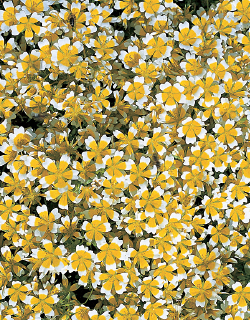
Vivid emerald green, feathery leaves create a dense ground cover persisting through winter, where seed has germinated in autumn. In late spring, the bright foliage is all but blotted out by even brighter, disc-shaped or shallow cupped flowers, each about 3cm (1in) across, with brilliant yellow centres and white petal margins. An excellent plant for attracting wildlife, especially beneficial hoverflies. Self-sows copiously.
Soil preference: Any, not too dry
Aspect: Sun or part shade
Season of interest: Spring, summer
Height and spread: 15cm × 20cm (6in × 8in)
Companion plants: Perfect for creating green or coloured ground cover between shrubs, particularly along border edges. Best when allowed to spread naturally, by self-sowing.
Mimulus
Monkey Flower, Musk Short-lived perennials and half hardy annuals
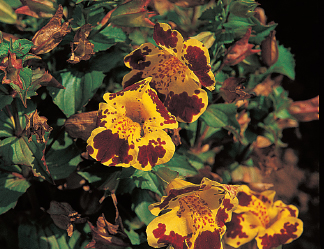
Mat forming perennials with slightly toothed leaves and a summer-long run of trumpet-shaped flowers in bright colours, often with stippling at the throat. Cultivars include ‘Highland Park’ (tomato red), ‘Puck’ (yellow) and ‘Wisley Red’ (scarlet). Seed series offer speckled and dramatically blotched blooms in shades of pink and cream though orange, red, maroon and yellow. ‘Monkey Magic’ is white with red markings.
Soil preference: Moist, but well-drained and fertile
Aspect: Sun or shade
Season of interest: Summer
Height and spread: From dwarf to 30cm × 45cm (1ft × 1ft 6in)
Companion plants: Ideal plants for a moist, part-shaded bedding scheme where they can accompany some of the taller primulas, such as Primula viallii. Seed series are useful for shaded containers with dark blue lobelia.
Lobelia erinus
Bedding Lobelia Tender perennial, invariably grown as annuals
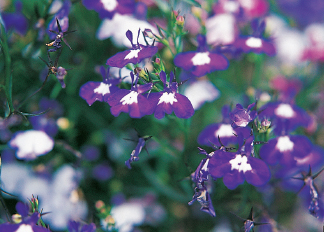
Compact or trailing herbs with thin stems, sometimes bronze-hued foliage and a constant succession of small flowers, with broad lower petals and a contrasting white eye. Colours include dark, mid- or pale blue, mauve, purple and white. Popular compact varieties include non-trailing ‘Palace Series’ and ‘Mrs Clibran’. Trailing kinds include the ‘Cascade Series’ and light blue ‘Periwinkle Blue’.
Soil preference: Moisture-retentive
Aspect: Sun or part shade
Season of interest: Summer
Height and spread: Variable to 20cm (8in), but trailing kinds have longer stems
Companion plants: The classic plant for edging borders, or for trailing from baskets. The blue is valuable for cooling colour schemes or for making strong contrasts with, for example, golden-flowered Bidens ferulifolia; looks attractive almost anywhere.
Tanacetum parthenium
Feverfew Perennial
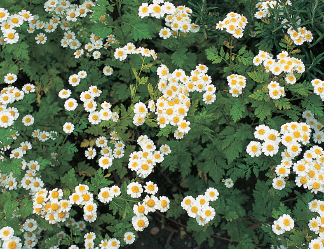
Bright green or gold, lobed leaves which are acridly aromatic when bruised. The yellow-centred, white flowers begin to emerge in late spring and are produced all summer. Cultivars include ‘Snowball’ (button blooms) and ‘Santana’. Will flower naturally but also responds well to frequent trimming. A prolific self-seeder, sometimes becoming a nuisance, but also a handy gap filler. The leaves are reputed to cure headaches.
Soil preference: Any
Aspect: Sun, partial shade or shade
Season of interest: Spring, summer, autumn
Height and spread: Variable to 45cm (1ft 6in), usually smaller
Companion plants: Useful as part of a carpet bedding scheme, or when the gold-leaf form ‘Aureum’ is planted among such plants as Impatiens or petunias, to tone down the intensity of the flowers.
Bedding for sustainable growing
Viola
Violas Perennials
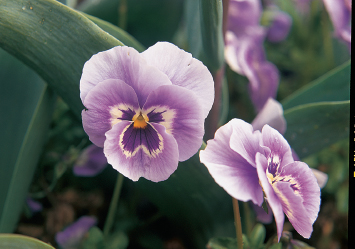
Mat-forming perennials with compact foliage and a constant succession of flowers, many of which are marked with face-like features. Garden violas are almost constantly in bloom with colours similar in range to pansies with many being bicoloured, plain or picotee. Varieties include ‘Ardross Gem’, ‘Irish Molly’ and ‘Martin’. Seed series include ‘Baby Face’, ‘Gemini Twins’ and ‘Sorbet’.
Soil preference: Any, well-drained, not too dry
Aspect: Sun or part shade
Season of interest: Year round
Height and spread: Up to 20cm × 30cm (8in × 1ft)
Companion plants: Universally loved and useful almost anywhere. New seed series of small flowered violas are superseding bigger flowered pansies because they can bloom throughout the year. Violas and pansies look good with almost any other garden plant.
Geranium pratense
Meadow Cranesbill Perennial
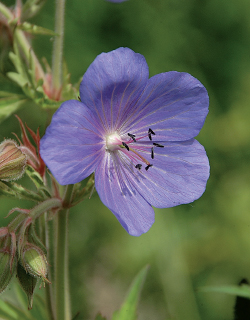
Raise from seed sown in autumn to provide flowers the following summer. Decorative foliage is divided with first flower stems developing in early summer producing bright blue flowers. Cut hard back to provide a second flush in late summer. There is a pure white form, and ‘Mrs Kendall Clark’ has pale slate-blue flowers.
Soil preference: Any
Aspect: Sun
Season of interest: Summer and autumn
Height and spread: 1m × 60cm (3ft 3in × 2ft)
Companion plants: Wild bedding is an unusual but exciting concept. Try this cranesbill with ox eye daisies (Leucanthemum vulgare) and with annual grasses such as Briza maxima or Lagurus ovata for a soft, meadow effect.
Aquilegia
Granny’s Bonnets, Columbine Perennials
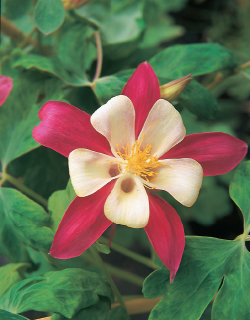
Sustainable bedding. Seed series of big, showy columbines are popular as bedding plants. Sown in spring, they will produce plenty of flower the following year and can be planted in situ in autumn. The ‘Songbird series’ have big, long-spurred blooms in red, blue, yellow and creamy white, which also make good container plants and can even be used for early conservatory displays.
Soil preference: Any, preferably fertile
Aspect: Sun, part-shade
Season of interest: Spring, early summer
Height and spread: Variable from dwarf to 1m (3ft 3in)
Companion plants: Best on their own in a bedding scheme, but beautiful if dotted among perennials or shrubs in a mixed border, or grown in containers.
Bedding for attracting wildlife
Verbena bonariensis
Purple Top, Tall Verbena Short-lived, marginally hardy perennial
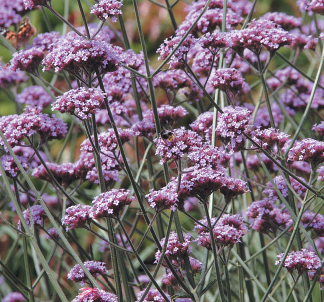
Tall stems, sparsely furnished with narrow, dark green leaves are topped, through summer, by dense bunches of tiny bright purple blooms. The stems are so thin and the leaves so few that the flowers seem suspended by invisible supports. Attractive to butterflies and a wide range of insects. A prolific self-seeder.
Soil preference: Any, even very dry
Aspect: Full sun
Season of interest: Summer, autumn.
Height and spread: 2m × 30cm (6ft 6in × 1ft)
Companion plants: Most effective when used to create an extra, ephemeral layer of bedding above more moderately sized plants such as bedding dahlias, pelargoniums or petunias.
Gaillardia hybrids
Blanket Flower; Fire Wheel Hardy perennials

Brilliantly coloured, daisy flowers with hot coloured outer rays and raised, furry central ‘cones’ are produced throughout summer. Typical flower colours are red and yellow, as in the old variety ‘Kobold’; ‘Burgunder’ is red and ‘Dazzler’, a shorter-stemmed variety. Divide or propagate from root cuttings frequently, since these perennials are short-lived. Loved by butterflies and bees.
Soil preference: Any free-draining
Aspect: Sun
Season of interest: Summer, autumn
Height and spread: Variable from dwarf to 60cm × 75cm (2ft × 2ft 6in)
Companion plants: For a hot effect, gaillardias mix well with annual varieties of Rudbeckia, such as ‘Marmalade’ or ‘Rustic Dwarfs’, whose flowers will continue long into autumn. Besides bedding, they also work well in mixed or herbaceous borders.
Nicotiana x sanderae
Tobacco Plant Half hardy annual
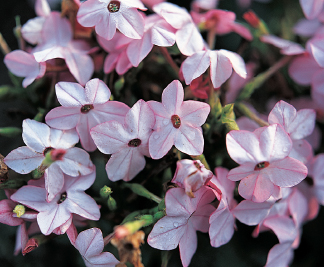
Bold perennial with large, oval, sticky leaves and branched stems bearing narrow-necked, trumpet-shaped flowers. Blooms on scented varieties wilt by day, but perk up at dusk and produce a rich fragrance. Best scented varieties are ‘Fragrant Cloud’ or ‘Evening Fragrance Mixed’. Decorative, non-scented kinds include ‘Domino’ and ‘Nikki’ series in pastel pink hues, and red, pink, cream or white. Particularly attractive to bees and moths.
Soil preference: Any
Aspect: Sun or part shade
Season of interest: Summer
Height and spread: Variable to 1m × 75cm (3ft 3in × 2ft 6in)
Companion plants: Coloured varieties call for strong foliage contrasts from silvery plants such as Centaurea cineraria or a filigree-leaved Artemisia. Scented kinds are good with the huge Nicotiana sylvestris.
Bedding for containers
Torenia
Wishbone Flower Tender perennial
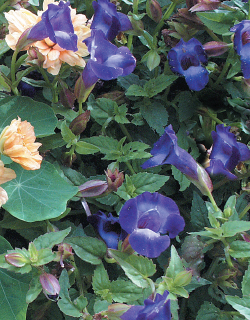
Bushy or slowly spreading perennials with toothed leaves and a long succession of lipped, trumpet flowers with dark petal edges and contrastingly pale throats. Good varieties for containers include ‘Amethyst’, ‘Blue Panda’ (royal blue and pale violet blue) and ‘Duchess Series’, which comes in two-tone blue, white and pink or white and blue.
Soil preference: Any, not too dry
Aspect: Sun or part shade
Season of interest: Summer



